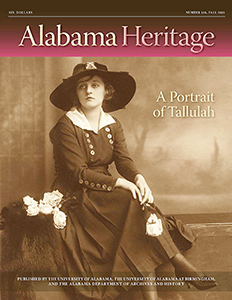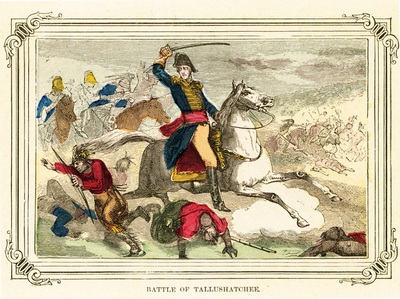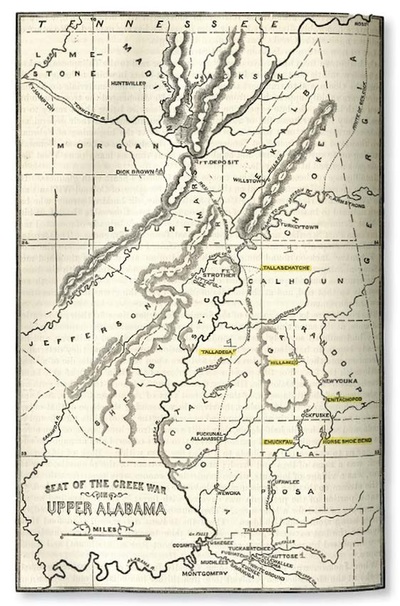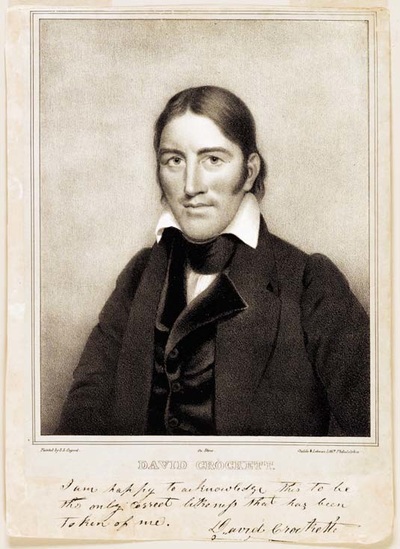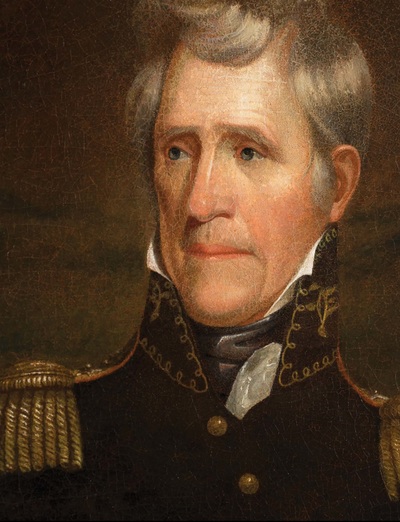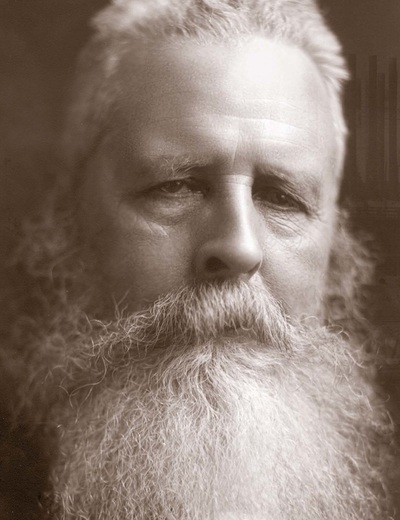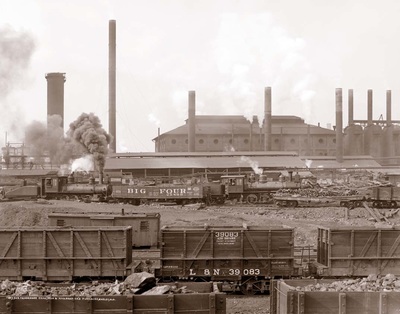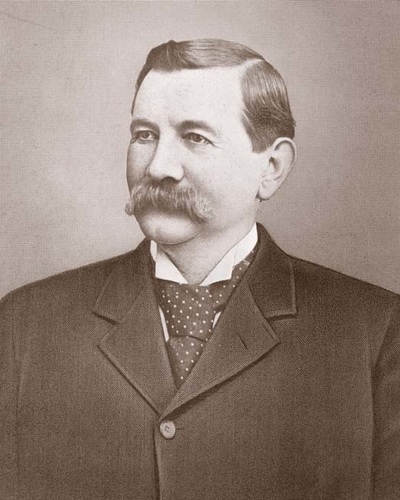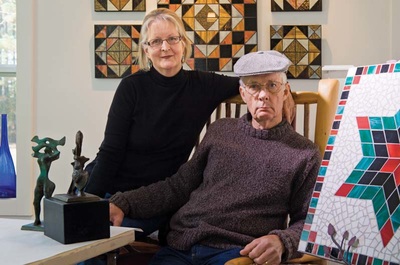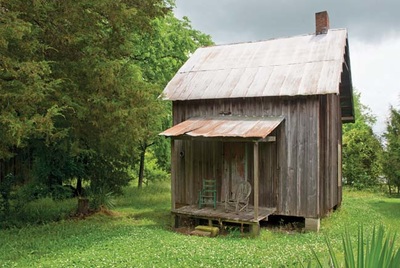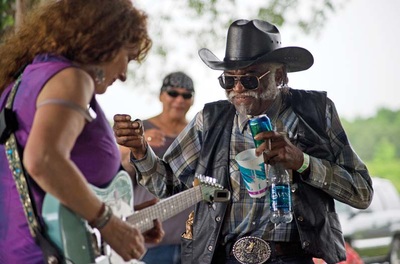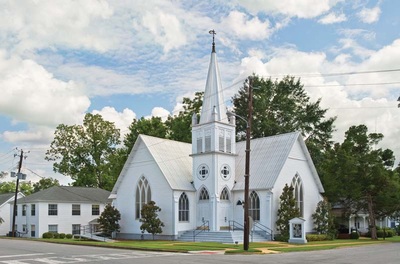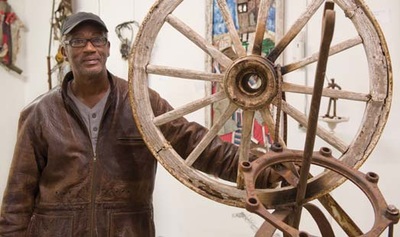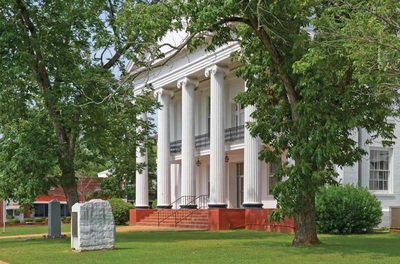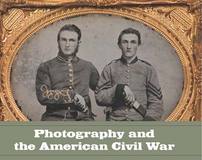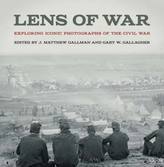|
On the cover: Aspiring actress Talullah Bankhead, aged 17, photographed in New York City. (Alabama Department of Archives and History)
|
FEATURE ABSTRACTS
Andrew Jackson's Fall Campaign in the Creek War (1813-1814)
by Susan M. Abram
As fall dawned in 1813 in Alabama, Andrew Jackson boasted about his plans to best the Red Stick Creeks and effectively disenfranchise them, preventing them from causing further conflict in the Alabama Territory. The frontiersmen, including David Crockett, and their allies waged brutal warfare against the Red Stick Creeks, and skirmishes unfolded throughout the territory, eventually arriving near Talladega, where Jackson attempted to replicate attack methods he had used successfully elsewhere. Although the Battle of Talladega was not a decisive victory for Jackson and his men, it did weaken some Red Stick allies to the point that they surrendered. The end of the war would not arrive for several long months, but after the fall campaign, its arrival was only a matter of time.
About the Author
Susan M. Abram, an independent scholar and adjunct instructor at Western Carolina University and Southwestern Community College, received her doctorate from Auburn University in 2009. In addition to teaching, Abram serves as the president of the North Carolina Trail of Tears Association that works with the National Parks Service to promote, protect, and preserve the Trail of Tears National Historic Trail. Her recent publications include the chapters “The Cherokee Beloved Occupation: Warfare, Gender, and Community” in New Men: Essays on Manliness in Early America (NYU Press, 2011) and “Cherokees in the Creek War” in Tohopeka: Rethinking the Creek War and the War of 1812 (Pebble Hill Books, 2012). Her forthcoming book, Forging a Cherokee-American Alliance in the Creek War: From Creation to Betrayal, is the winner of the 2013 Anne B. and James B. McMillan Prize in Southern History and is scheduled for release by the University of Alabama Press in November 2015.
Additional Information
by Susan M. Abram
As fall dawned in 1813 in Alabama, Andrew Jackson boasted about his plans to best the Red Stick Creeks and effectively disenfranchise them, preventing them from causing further conflict in the Alabama Territory. The frontiersmen, including David Crockett, and their allies waged brutal warfare against the Red Stick Creeks, and skirmishes unfolded throughout the territory, eventually arriving near Talladega, where Jackson attempted to replicate attack methods he had used successfully elsewhere. Although the Battle of Talladega was not a decisive victory for Jackson and his men, it did weaken some Red Stick allies to the point that they surrendered. The end of the war would not arrive for several long months, but after the fall campaign, its arrival was only a matter of time.
About the Author
Susan M. Abram, an independent scholar and adjunct instructor at Western Carolina University and Southwestern Community College, received her doctorate from Auburn University in 2009. In addition to teaching, Abram serves as the president of the North Carolina Trail of Tears Association that works with the National Parks Service to promote, protect, and preserve the Trail of Tears National Historic Trail. Her recent publications include the chapters “The Cherokee Beloved Occupation: Warfare, Gender, and Community” in New Men: Essays on Manliness in Early America (NYU Press, 2011) and “Cherokees in the Creek War” in Tohopeka: Rethinking the Creek War and the War of 1812 (Pebble Hill Books, 2012). Her forthcoming book, Forging a Cherokee-American Alliance in the Creek War: From Creation to Betrayal, is the winner of the 2013 Anne B. and James B. McMillan Prize in Southern History and is scheduled for release by the University of Alabama Press in November 2015.
Additional Information
- For more information, please consult the following resources:
- For information on the Creek War, 1813-1814, see the Encyclopedia of Alabama article.
- For information on the Battle of Talladega, see the Encyclopedia of Alabama article.
James Bowron: An Alabama Industrialist
by Robert J. Norrell
As the nineteenth century progressed, the industrial revolution subsumed many cities, and Birmingham was no exception. However, one Birmingham man within that industry did prove exceptional: James Bowron not only served as an executive in the iron and steel industries, but he also devoted substantial time to chronicling himself, his state, and his era through his diaries and an autobiography. For Bowron, such a pursuit was spiritual, in keeping with his Quaker beliefs and the imperative to reflect upon one’s actions and soul. However, for the rest of us—all his readers—the numerous writings he left offer substantial and valuable insights, a unique portrait of a Birmingham businessman and the city in which he made his life and career.
by Robert J. Norrell
As the nineteenth century progressed, the industrial revolution subsumed many cities, and Birmingham was no exception. However, one Birmingham man within that industry did prove exceptional: James Bowron not only served as an executive in the iron and steel industries, but he also devoted substantial time to chronicling himself, his state, and his era through his diaries and an autobiography. For Bowron, such a pursuit was spiritual, in keeping with his Quaker beliefs and the imperative to reflect upon one’s actions and soul. However, for the rest of us—all his readers—the numerous writings he left offer substantial and valuable insights, a unique portrait of a Birmingham businessman and the city in which he made his life and career.
About the Author
Robert J. “Jeff” Norrell grew up in Hazel Green in Madison County, Alabama. He earned his PhD at the University of Virginia. He holds the Bernadotte Schmitt Chair of Excellence at the University of Tennessee, prior to which he taught at Birmingham-Southern College and the University of Alabama. In 2015 Norrell is publishing three books: Alex Haley and the Books that Changed a Nation (St. Martin’s Press); Tuckeleechee Cove: Faces of the Past (University of Tennessee Press); and Transnational History Has a Negro Problem: Alabama in Africa and the Misuses of the Past (Edwin Mellen Press). His 2009 biography, Up from History: the Life of Booker T. Washington (Belknap Press), won national acclaim. In 2005 he published The House I Live In: Race in the American Century (Oxford University Press). His Reaping the Whirlwind: The Civil Rights Movement in Tuskegee (Knopf) won the Robert F. Kennedy Book Award in 1986. He is the author of seven additional books and twenty scholarly articles. His most recent book is a novel, Eden Rise (NewSouth Books, 2012), set during the civil rights movement in Alabama.
Additional Information
Robert J. “Jeff” Norrell grew up in Hazel Green in Madison County, Alabama. He earned his PhD at the University of Virginia. He holds the Bernadotte Schmitt Chair of Excellence at the University of Tennessee, prior to which he taught at Birmingham-Southern College and the University of Alabama. In 2015 Norrell is publishing three books: Alex Haley and the Books that Changed a Nation (St. Martin’s Press); Tuckeleechee Cove: Faces of the Past (University of Tennessee Press); and Transnational History Has a Negro Problem: Alabama in Africa and the Misuses of the Past (Edwin Mellen Press). His 2009 biography, Up from History: the Life of Booker T. Washington (Belknap Press), won national acclaim. In 2005 he published The House I Live In: Race in the American Century (Oxford University Press). His Reaping the Whirlwind: The Civil Rights Movement in Tuskegee (Knopf) won the Robert F. Kennedy Book Award in 1986. He is the author of seven additional books and twenty scholarly articles. His most recent book is a novel, Eden Rise (NewSouth Books, 2012), set during the civil rights movement in Alabama.
Additional Information
- Norrell’s book James Bowron: The Autobiography of a New South Industrialist is available for purchase through solicitation. Contact the author here: Robert J. Norrell, 38 Rose of Sharon Way, Chandler, NC 28715; (256) 701-1211; [email protected]
- For additional information, the author recommends the following:
- Pratt Coal, for a further understanding of the development of the coal mining industry within the state of Alabama.
 Actress Tallulah Bankhead sat for the iconic portrait by Augustus John in 1929, at the height of her fame on the London stage. (National Portrait Gallery, Smithsonian Institution/Art Resource, NY)
Actress Tallulah Bankhead sat for the iconic portrait by Augustus John in 1929, at the height of her fame on the London stage. (National Portrait Gallery, Smithsonian Institution/Art Resource, NY)
"My Most Valuable Possession": Tallulah Bankhead's Portrait by Augustus John
By Guy R. Swanson
Visitors to the Smithsonian Institution’s National Portrait Gallery in Washington, DC, may notice a colorful portrait of actress Tallulah Bankhead, but they may not be aware of the painting’s rich history. As a young woman, Bankhead, an Alabama native, set out for New York then relocated to England, hoping to secure a place of distinction in film and theater history. One marker of her success is the portrait, painted by talented artist Augustus John, a sensation all his own. Upon its premiere, the painting “caused a great stir,” evoking praise from some critics and less approving reactions from others. However, Bankhead remained devoted to the work, and she consistently refused to sell it, transporting it with her to various residences across the globe. Author Guy Swanson charts the portrait’s provenance and prominent place in the life of its sitter.
About the Author
Guy R. Swanson teaches high school history courses for Henderson County Public Schools in North Carolina. He received his BA from Michigan State University, a MA and a MLS from the University of Alabama, and a MSA from Western Carolina University. Swanson has authored several articles (including two for Alabama Heritage), a study about Confederate money published by The British Museum, and he is coauthor of White House of the Confederacy: An Illustrated History (Cadmus Fine Books, 1993). During the preparation of this article Swanson appreciated the assistance of Kelly Cubbin, Fred Hansen, Jesseca Heatherly, Phil Neville, Rick and Tiffany Prudhomme, and Erin Shanley; Jennie Kemp, Tuscaloosa Public Library; and the editorial staff of Alabama Heritage.
Additional Information
For more information, please consult the following resources:
For information on the Tallulah Bankhead, see the Encyclopedia of Alabama article.
For information about the Smithsonian Institution’s National Portrait Gallery, please visit its website.
By Guy R. Swanson
Visitors to the Smithsonian Institution’s National Portrait Gallery in Washington, DC, may notice a colorful portrait of actress Tallulah Bankhead, but they may not be aware of the painting’s rich history. As a young woman, Bankhead, an Alabama native, set out for New York then relocated to England, hoping to secure a place of distinction in film and theater history. One marker of her success is the portrait, painted by talented artist Augustus John, a sensation all his own. Upon its premiere, the painting “caused a great stir,” evoking praise from some critics and less approving reactions from others. However, Bankhead remained devoted to the work, and she consistently refused to sell it, transporting it with her to various residences across the globe. Author Guy Swanson charts the portrait’s provenance and prominent place in the life of its sitter.
About the Author
Guy R. Swanson teaches high school history courses for Henderson County Public Schools in North Carolina. He received his BA from Michigan State University, a MA and a MLS from the University of Alabama, and a MSA from Western Carolina University. Swanson has authored several articles (including two for Alabama Heritage), a study about Confederate money published by The British Museum, and he is coauthor of White House of the Confederacy: An Illustrated History (Cadmus Fine Books, 1993). During the preparation of this article Swanson appreciated the assistance of Kelly Cubbin, Fred Hansen, Jesseca Heatherly, Phil Neville, Rick and Tiffany Prudhomme, and Erin Shanley; Jennie Kemp, Tuscaloosa Public Library; and the editorial staff of Alabama Heritage.
Additional Information
For more information, please consult the following resources:
For information on the Tallulah Bankhead, see the Encyclopedia of Alabama article.
For information about the Smithsonian Institution’s National Portrait Gallery, please visit its website.
Visions of the Black Belt
by Robin McDonald and Valerie Pope Burnes
Although it sits geographically right in the heart of Alabama, for many people the Black Belt remains an overlooked treasure. In this article, excerpted from the authors’ new book, Visions of the Black Belt: A Cultural Survey of the Heart of Alabama, Robin McDonald and Valerie Pope Burnes explore this lovely and historically rich region through text and photography, highlighting its unique contribution to the state’s culture and history.
by Robin McDonald and Valerie Pope Burnes
Although it sits geographically right in the heart of Alabama, for many people the Black Belt remains an overlooked treasure. In this article, excerpted from the authors’ new book, Visions of the Black Belt: A Cultural Survey of the Heart of Alabama, Robin McDonald and Valerie Pope Burnes explore this lovely and historically rich region through text and photography, highlighting its unique contribution to the state’s culture and history.
About the Authors
Robin McDonald has been the designer and principal photographer for Alabama Heritage since 1991. From 1979 to 1989, he was the art director of Horizon magazine. His first book, Heart of a Small Town: Photographs of Alabama Towns (University of Alabama Press), was published in 2003. Valerie Pope Burnes is assistant professor of history at the University of West Alabama and the former director of the Center for the Study of the Black Belt. She earned her PhD from Auburn University.
Additional Information
Visions of the Black Belt: A Cultural Survey of the Heart of Alabama, available from the publisher, University of Alabama Press.
Robin McDonald has been the designer and principal photographer for Alabama Heritage since 1991. From 1979 to 1989, he was the art director of Horizon magazine. His first book, Heart of a Small Town: Photographs of Alabama Towns (University of Alabama Press), was published in 2003. Valerie Pope Burnes is assistant professor of history at the University of West Alabama and the former director of the Center for the Study of the Black Belt. She earned her PhD from Auburn University.
Additional Information
Visions of the Black Belt: A Cultural Survey of the Heart of Alabama, available from the publisher, University of Alabama Press.
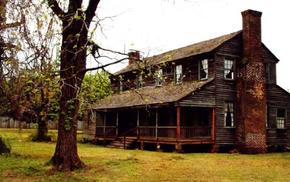 The Sadler House was expanded from a log cabin by Isaac Sadler, starting in 1835.
The Sadler House was expanded from a log cabin by Isaac Sadler, starting in 1835.
Places in Peril 2015: Alabama's Endangered Historic Landmarks
by Michael W. Panhorst
Each year the Alabama Trust for Historic Preservation identifies structures across the state that are in dire need of preservation, and Alabama Heritage helps alert readers to these important preservation opportunities. This year’s sites include the Malbis Plantation Historic District in Baldwin County, the Braxton Bragg Comer Bridge in Jackson County, Jacksonville’s Forney Hall, McCalla’s Sadler House, and the Montgomery Theatre Building, located in Montgomery. Alabama Heritage readers have long been valuable allies in preservation efforts of structures such as these from the Places in Peril list.
About the Authors
Michael W. Panhorst, PhD, is a historian of art and architecture and a board member of the Alabama Trust for Historic Preservation, a statewide membership organization devoted to the protection and promotion of Alabama’s historic architecture. He has coordinated the “Places in Peril” program since 2014. His “The Tabernacle: Centerpiece of Alabama’s Early Camp Meetings” appeared in Alabama Heritage, winter 2015.
Additional Information
For more information, and to nominate a Place in Peril for 2016, please visit www.alabamatrust.info, email [email protected], or call (205) 652-3497.
To read about more places in peril, click here for our Places in Peril blog.
by Michael W. Panhorst
Each year the Alabama Trust for Historic Preservation identifies structures across the state that are in dire need of preservation, and Alabama Heritage helps alert readers to these important preservation opportunities. This year’s sites include the Malbis Plantation Historic District in Baldwin County, the Braxton Bragg Comer Bridge in Jackson County, Jacksonville’s Forney Hall, McCalla’s Sadler House, and the Montgomery Theatre Building, located in Montgomery. Alabama Heritage readers have long been valuable allies in preservation efforts of structures such as these from the Places in Peril list.
About the Authors
Michael W. Panhorst, PhD, is a historian of art and architecture and a board member of the Alabama Trust for Historic Preservation, a statewide membership organization devoted to the protection and promotion of Alabama’s historic architecture. He has coordinated the “Places in Peril” program since 2014. His “The Tabernacle: Centerpiece of Alabama’s Early Camp Meetings” appeared in Alabama Heritage, winter 2015.
Additional Information
For more information, and to nominate a Place in Peril for 2016, please visit www.alabamatrust.info, email [email protected], or call (205) 652-3497.
To read about more places in peril, click here for our Places in Peril blog.
DEPARTMENT ABSTRACTS
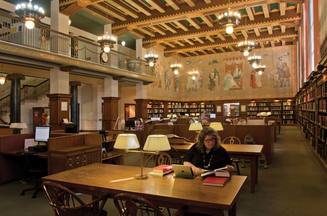 Donna Cox Baker hunts ancestors at Birmingham Public Library’s Linn-Henley Research Library, listed in Family Tree Magazine’s top-ten public genealogy collections. (Robin McDonald)
Donna Cox Baker hunts ancestors at Birmingham Public Library’s Linn-Henley Research Library, listed in Family Tree Magazine’s top-ten public genealogy collections. (Robin McDonald)
Adventures in Genealogy
My Glorious Addiction
By Donna Cox Baker
Editor’s Note: The Alabama Heritage team proudly introduces “Adventures in Genealogy,” a regular department that will spotlight the many ways people are uncovering their roots in Alabama. We thank genealogy experts Yvonne Crumpler and Elizabeth Wells for agreeing to serve as the department editors and the HudsonAlpha Institute for Biotechnology for sponsoring this department.
In this first installment of “Adventures in Alabama Genealogy,” Alabama Heritage Editor Donna Cox Baker traces her own interest in family research, noting several of the valuable resources available to Alabamians and making recommendations on how to start retracing your own genealogy. Department editors offer additional tips and resources for those interested in learning more about their ancestry.
About the Author
Donna Cox Baker has served as the editor-in-chief of Alabama Heritage since 2002. Elizabeth Crabtree Wells is the processing archivist and special collection librarian at Samford University Library in Birmingham, Alabama. Yvonne Shelton Crumpler retired in 2008 from the Tutwiler Collection of Southern History and Literature where she had worked as a research librarian in special collections for thirty-four years. Department sponsor, HudsonAlpha Institute for Biotechnology, is a global leader in DNA research.
Additional Information
For additional information, the author recommends the following resources:
My Glorious Addiction
By Donna Cox Baker
Editor’s Note: The Alabama Heritage team proudly introduces “Adventures in Genealogy,” a regular department that will spotlight the many ways people are uncovering their roots in Alabama. We thank genealogy experts Yvonne Crumpler and Elizabeth Wells for agreeing to serve as the department editors and the HudsonAlpha Institute for Biotechnology for sponsoring this department.
In this first installment of “Adventures in Alabama Genealogy,” Alabama Heritage Editor Donna Cox Baker traces her own interest in family research, noting several of the valuable resources available to Alabamians and making recommendations on how to start retracing your own genealogy. Department editors offer additional tips and resources for those interested in learning more about their ancestry.
About the Author
Donna Cox Baker has served as the editor-in-chief of Alabama Heritage since 2002. Elizabeth Crabtree Wells is the processing archivist and special collection librarian at Samford University Library in Birmingham, Alabama. Yvonne Shelton Crumpler retired in 2008 from the Tutwiler Collection of Southern History and Literature where she had worked as a research librarian in special collections for thirty-four years. Department sponsor, HudsonAlpha Institute for Biotechnology, is a global leader in DNA research.
Additional Information
For additional information, the author recommends the following resources:
- Family Search for statewide genealogy records
- Birmingham Public Library’s Linn-Henley Research Library for hours, contact information, directions, as well as a virtual tour.
- Family Tree Magazine to further develop budding interest in genealogy.
Becoming Alabama
Quarter by Quarter
By Joseph W. Pearson, Megan L. Bever, and Matthew L. Downs
Editor’s Note—For the past five years this department has appeared as part of the statewide “Becoming Alabama” initiative—a cooperative venture of state organizations to commemorate Alabama’s experiences related to the Creek War, the Civil War, and the civil rights movement. Throughout this time, we have marked many milestone anniversaries of significant Alabama moments from 200, 150, and 50 years ago—sometimes describing pivotal events, sometimes describing daily life, but always illuminating a world in flux. In this final installment of “Becoming Alabama,” authors Joseph W. Pearson, Megan L. Bever, and Matthew L. Downs—each of whom began writing this column as a graduate student in the University of Alabama’s department of history, and each of whom has now matriculated and begun a professorial career—offer a summation of the movements they covered, all the while recalling that history itself is still unfolding. Alabama Heritage would like to thank the partners who have helped support and make this “Becoming Alabama” department possible: the Summersell Center for the Study of the South, the University of Alabama Department of History, and the Alabama Tourism Department.
In this final installment of the “Becoming Alabama” column, Joseph Pearson looks at the effects of the Creek War. Megan Bever considers the aftermath of the Civil War and the beginning of Radical Reconstruction, detailing in particular the effects it had on newly freed African Americans. Finally, Matthew Downs reflects on the Watts riots, the evolving nature of the civil rights movement, and the continued work of activists in the era following the passage of the Voting Rights Act.
About the Authors
Joseph W. Pearson is assistant professor of history at Union College. His dissertation, completed at the University of Alabama, explores the political culture of the American Whigs, specifically probing the shared underpinnings of their political thought and moral temper across class, gender, and section.
Megan L. Bever is assistant professor of history at Missouri Southern State University. Her dissertation, completed at the University of Alabama, explores alcohol, morality, and citizenship in the Civil War era.
Matthew L. Downs (PhD, Alabama) is an assistant professor of history at the University of Mobile. His dissertation focused on the federal government’s role in the economic development of the Tennessee Valley.
Additional Information
For more information, please consult the following resources.
Quarter by Quarter
By Joseph W. Pearson, Megan L. Bever, and Matthew L. Downs
Editor’s Note—For the past five years this department has appeared as part of the statewide “Becoming Alabama” initiative—a cooperative venture of state organizations to commemorate Alabama’s experiences related to the Creek War, the Civil War, and the civil rights movement. Throughout this time, we have marked many milestone anniversaries of significant Alabama moments from 200, 150, and 50 years ago—sometimes describing pivotal events, sometimes describing daily life, but always illuminating a world in flux. In this final installment of “Becoming Alabama,” authors Joseph W. Pearson, Megan L. Bever, and Matthew L. Downs—each of whom began writing this column as a graduate student in the University of Alabama’s department of history, and each of whom has now matriculated and begun a professorial career—offer a summation of the movements they covered, all the while recalling that history itself is still unfolding. Alabama Heritage would like to thank the partners who have helped support and make this “Becoming Alabama” department possible: the Summersell Center for the Study of the South, the University of Alabama Department of History, and the Alabama Tourism Department.
In this final installment of the “Becoming Alabama” column, Joseph Pearson looks at the effects of the Creek War. Megan Bever considers the aftermath of the Civil War and the beginning of Radical Reconstruction, detailing in particular the effects it had on newly freed African Americans. Finally, Matthew Downs reflects on the Watts riots, the evolving nature of the civil rights movement, and the continued work of activists in the era following the passage of the Voting Rights Act.
About the Authors
Joseph W. Pearson is assistant professor of history at Union College. His dissertation, completed at the University of Alabama, explores the political culture of the American Whigs, specifically probing the shared underpinnings of their political thought and moral temper across class, gender, and section.
Megan L. Bever is assistant professor of history at Missouri Southern State University. Her dissertation, completed at the University of Alabama, explores alcohol, morality, and citizenship in the Civil War era.
Matthew L. Downs (PhD, Alabama) is an assistant professor of history at the University of Mobile. His dissertation focused on the federal government’s role in the economic development of the Tennessee Valley.
Additional Information
For more information, please consult the following resources.
- The complete “Becoming Alabama” series is available on our website.
- For information on the Creek War, 1813-1814, see the Encyclopedia of Alabama at http://www.encyclopediaofalabama.org/article/h-1820.
- For information on the Civil War throughout the United States, see the Encyclopedia of Alabama at http://www.encyclopediaofalabama.org/article/s-130 and for its specific role in Alabama, see http://www.encyclopediaofalabama.org/article/h-1429.
- For information on the civil rights movement, see the Encyclopedia of Alabama at http://www.encyclopediaofalabama.org/article/h-1580 and http://www.encyclopediaofalabama.org/article/s-121
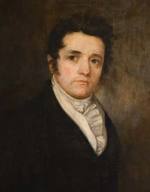 Gabriel Moore, painted by Edna K. Smith in 1912. (Alabama Department of Archives and History)
Gabriel Moore, painted by Edna K. Smith in 1912. (Alabama Department of Archives and History)
Alabama Governors
Gabriel Moore
by Samuel L. Webb
In this quarter’s installment of “Alabama Governors,” Samuel Webb revisits the term of Alabama’s fifth governor, Gabriel Moore. Moore, a native of North Carolina, served Alabama not only as governor, but also as United States Senator. However, his political career ended tumultuously, and he spent his later years in Texas rather than remaining in the state he served for many years prior.
About the Author
Samuel L. Webb holds a JD from the University of Alabama School of Law and a PhD in history from the University of Arkansas. This department is drawn from Alabama Governors: A Political History of the State, Second Edition, edited by Webb and Margaret E. Armbrester.
Additional Information
Alabama Governors (http://www.uapress.ua.edu/product/Alabama-Governors,5928.aspx)
See the Encyclopedia of Alabama for further reading on Alabama governor and US congressman, Gabriel Moore.
Gabriel Moore
by Samuel L. Webb
In this quarter’s installment of “Alabama Governors,” Samuel Webb revisits the term of Alabama’s fifth governor, Gabriel Moore. Moore, a native of North Carolina, served Alabama not only as governor, but also as United States Senator. However, his political career ended tumultuously, and he spent his later years in Texas rather than remaining in the state he served for many years prior.
About the Author
Samuel L. Webb holds a JD from the University of Alabama School of Law and a PhD in history from the University of Arkansas. This department is drawn from Alabama Governors: A Political History of the State, Second Edition, edited by Webb and Margaret E. Armbrester.
Additional Information
Alabama Governors (http://www.uapress.ua.edu/product/Alabama-Governors,5928.aspx)
See the Encyclopedia of Alabama for further reading on Alabama governor and US congressman, Gabriel Moore.
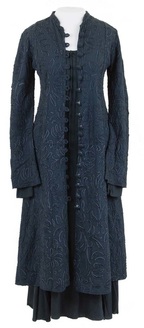 An Alabama Chanin long swing coat and dolman tuck dress made from 100% lightweight organic cotton jersey (Alabama Department of Archives and History)
An Alabama Chanin long swing coat and dolman tuck dress made from 100% lightweight organic cotton jersey (Alabama Department of Archives and History)
From the Archives
Alabama and the Textile Industry
By Ryan Blocker and Georgia Ann Conner
This quarter’s installment of “From the Archives” illuminates an often-overlooked part of Alabama’s industrial history: textiles. Archivists from the Alabama Department of Archives and History (ADAH) explore the ADAH collection and the influence of textiles on the state, from the early nineteenth century, when the first bales of cotton left Alabama’s shores, until the current day, when fashion trends include clothing from Alabama designers such as Billy Reid, Natalie Chanin, and Gina Locklear.
About the Authors
Ryan Blocker is a collections curator specializing in textiles at the Alabama Department of Archives and History. Georgia Ann Conner is the communications officer at the Alabama Department of Archives and
History.
Additional Information
Visit the Museum of Alabama or call (334) 242-4435, for more information.
Alabama and the Textile Industry
By Ryan Blocker and Georgia Ann Conner
This quarter’s installment of “From the Archives” illuminates an often-overlooked part of Alabama’s industrial history: textiles. Archivists from the Alabama Department of Archives and History (ADAH) explore the ADAH collection and the influence of textiles on the state, from the early nineteenth century, when the first bales of cotton left Alabama’s shores, until the current day, when fashion trends include clothing from Alabama designers such as Billy Reid, Natalie Chanin, and Gina Locklear.
About the Authors
Ryan Blocker is a collections curator specializing in textiles at the Alabama Department of Archives and History. Georgia Ann Conner is the communications officer at the Alabama Department of Archives and
History.
Additional Information
Visit the Museum of Alabama or call (334) 242-4435, for more information.
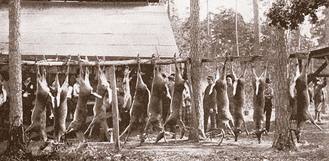 Wildlife conservation as practiced at an Allison reserve, thirty miles from Demopolis in the Alabama Black Belt. (Alabama Department of Archives and History)
Wildlife conservation as practiced at an Allison reserve, thirty miles from Demopolis in the Alabama Black Belt. (Alabama Department of Archives and History)
Alabama Politics
Alabama’s 1907 Game Law: The Politics of Hunting
By Mark Hersey
At the turn of the twentieth century, the state of Alabama began regulating many of its natural resources, including wildlife. Although intended to protect and conserve these resources through regulation of hunting and other activities, these regulations helped both reflect and shape the citizens’ daily practices and customs, offering a commentary on race relations and leading to the creation of groups such as hunting clubs.
About the Author
Mark D. Hersey is an associate professor of history at Mississippi State University where he directs the Center for the History of Agriculture, Science, and the Environment of the South (CHASES). Joshua D. Rothman, standing editor of the “Alabama Politics” department of Alabama Heritage, is professor of history at the University of Alabama and director of the university’s Frances S. Summersell Center for the Study of the South, which sponsors this department.
Additional Information
Visit Alabama Department of Conservation and Natural Resources to see what developed from these first laws regulating hunting and fishing.
Alabama’s 1907 Game Law: The Politics of Hunting
By Mark Hersey
At the turn of the twentieth century, the state of Alabama began regulating many of its natural resources, including wildlife. Although intended to protect and conserve these resources through regulation of hunting and other activities, these regulations helped both reflect and shape the citizens’ daily practices and customs, offering a commentary on race relations and leading to the creation of groups such as hunting clubs.
About the Author
Mark D. Hersey is an associate professor of history at Mississippi State University where he directs the Center for the History of Agriculture, Science, and the Environment of the South (CHASES). Joshua D. Rothman, standing editor of the “Alabama Politics” department of Alabama Heritage, is professor of history at the University of Alabama and director of the university’s Frances S. Summersell Center for the Study of the South, which sponsors this department.
Additional Information
Visit Alabama Department of Conservation and Natural Resources to see what developed from these first laws regulating hunting and fishing.
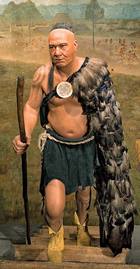 The Bottle Creek mound exhibit shows a Mississippian chief mounting the steps of a mound. Behind him is a three-story mural depicting the daily lives of the Indians. (Dave Snyder)
The Bottle Creek mound exhibit shows a Mississippian chief mounting the steps of a mound. Behind him is a three-story mural depicting the daily lives of the Indians. (Dave Snyder)
Revealing Hidden Collections
South Alabama’s Archaeology Museum: A New Encounter with the Past
By Frye Gaillard
Thanks to efforts of archaeologists and historians—and led by Alabama Heritage contributor Greg Waslkov—a new museum on the history of human habitation on the Alabama Gulf Coast resides in the Alfred and Lucile Delchamps Archaeology Building at the University of South Alabama. In the museum, visitors see archaeological artifacts and learn what they reveal about the people living in south Alabama throughout the centuries. The museum illuminates the lives of the many peoples who have graced Alabama’s southern region, from native populations to colonizers (both Native American and European), African Americans and Civil War soldiers.
About the Author
Frye Gaillard is writer-in-residence at the University of South Alabama. Louis A. Pitschmann, standing editor of the “Revealing Hidden Collections” department of Alabama Heritage, is dean of the University Libraries at the University of Alabama and director of the Alabama Center for the Book, which co-sponsor this department
Additional Information
Visit the museum’s website for further information.
South Alabama’s Archaeology Museum: A New Encounter with the Past
By Frye Gaillard
Thanks to efforts of archaeologists and historians—and led by Alabama Heritage contributor Greg Waslkov—a new museum on the history of human habitation on the Alabama Gulf Coast resides in the Alfred and Lucile Delchamps Archaeology Building at the University of South Alabama. In the museum, visitors see archaeological artifacts and learn what they reveal about the people living in south Alabama throughout the centuries. The museum illuminates the lives of the many peoples who have graced Alabama’s southern region, from native populations to colonizers (both Native American and European), African Americans and Civil War soldiers.
About the Author
Frye Gaillard is writer-in-residence at the University of South Alabama. Louis A. Pitschmann, standing editor of the “Revealing Hidden Collections” department of Alabama Heritage, is dean of the University Libraries at the University of Alabama and director of the Alabama Center for the Book, which co-sponsor this department
Additional Information
Visit the museum’s website for further information.
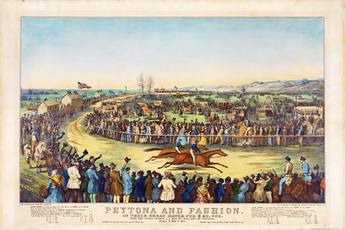 Starting in the 1820s, the Union Race Course in Queens, New York, held races matching the best horse from the North against the best horse from the South. The last of these races, in 1845, was won by an Alabama horse, Peytona, from Florence. (Library of Congress)
Starting in the 1820s, the Union Race Course in Queens, New York, held races matching the best horse from the North against the best horse from the South. The last of these races, in 1845, was won by an Alabama horse, Peytona, from Florence. (Library of Congress)
Portraits and Landscapes
Alabama and Thoroughbred Racing
By Charles Cort
Although today most people associate Thoroughbreds with Kentucky bluegrass, in the nineteenth century, Alabamians made several significant contributions to the sport. Several different Alabamians have won the Kentucky Derby (both as owner and as trainer), and horses from Alabama have won some of the sport’s most significant races, including some of the nineteenth century’s fiercely contested “match races,” which pitted a southern champion against a northern one. Charles Cort traces these events and explores many ways in which the Sport of Kings connects to Alabama.
About the Author
Charles Cort is a graduate of Hendrix College in Conway, Arkansas, and also has a MEd from the University of Montevallo. He lives in Spanish Fort, Alabama.
Additional Information
For further information on Alabama figures involved in Thoroughbred racing, please see the Encyclopedia of Alabama.
For information on horses in Alabama more broadly, please see the Encyclopedia of Alabama.
Alabama and Thoroughbred Racing
By Charles Cort
Although today most people associate Thoroughbreds with Kentucky bluegrass, in the nineteenth century, Alabamians made several significant contributions to the sport. Several different Alabamians have won the Kentucky Derby (both as owner and as trainer), and horses from Alabama have won some of the sport’s most significant races, including some of the nineteenth century’s fiercely contested “match races,” which pitted a southern champion against a northern one. Charles Cort traces these events and explores many ways in which the Sport of Kings connects to Alabama.
About the Author
Charles Cort is a graduate of Hendrix College in Conway, Arkansas, and also has a MEd from the University of Montevallo. He lives in Spanish Fort, Alabama.
Additional Information
For further information on Alabama figures involved in Thoroughbred racing, please see the Encyclopedia of Alabama.
For information on horses in Alabama more broadly, please see the Encyclopedia of Alabama.
 Nestling black vultures at a hidden Mountain State Park. (David M. Frings)
Nestling black vultures at a hidden Mountain State Park. (David M. Frings)
Nature Journal
Baby Buzzards
By L.J. Davenport
In this quarter’s installment of “Nature Journal,” Larry Davenport offers a delightful tale of baby buzzards (also known as black vultures) hatching at Oak Mountain State Park, including fascinating details about the life and behavior of this important species.
About the Author
Larry Davenport is a professor of biological & environmental Sciences at Samford University, Birmingham, Alabama.
Baby Buzzards
By L.J. Davenport
In this quarter’s installment of “Nature Journal,” Larry Davenport offers a delightful tale of baby buzzards (also known as black vultures) hatching at Oak Mountain State Park, including fascinating details about the life and behavior of this important species.
About the Author
Larry Davenport is a professor of biological & environmental Sciences at Samford University, Birmingham, Alabama.
Reading the Southern Past
Photographing the Civil War
By Stephen Goldfarb
This quarter’s installment of “Reading the Southern Past” reviews two texts on Civil War-era photography. Under consideration are Jeff Rosenheim’s Photography and the American Civil War (Metropolitan Museum of Art/Yale University Press, 2013) and the anthology Lens of War: Exploring Iconic Photographs of the Civil War, edited by Matthew Gallman and Gary W. Gallagher (University of Georgia Press, 2015). Both books offer new views of the way that the emerging technology of photography helped record the events of the Civil War.
About the Author
Stephen Goldfarb holds a PhD in the history of science and technology. He retired from a public library in 2003.
Photographing the Civil War
By Stephen Goldfarb
This quarter’s installment of “Reading the Southern Past” reviews two texts on Civil War-era photography. Under consideration are Jeff Rosenheim’s Photography and the American Civil War (Metropolitan Museum of Art/Yale University Press, 2013) and the anthology Lens of War: Exploring Iconic Photographs of the Civil War, edited by Matthew Gallman and Gary W. Gallagher (University of Georgia Press, 2015). Both books offer new views of the way that the emerging technology of photography helped record the events of the Civil War.
About the Author
Stephen Goldfarb holds a PhD in the history of science and technology. He retired from a public library in 2003.
